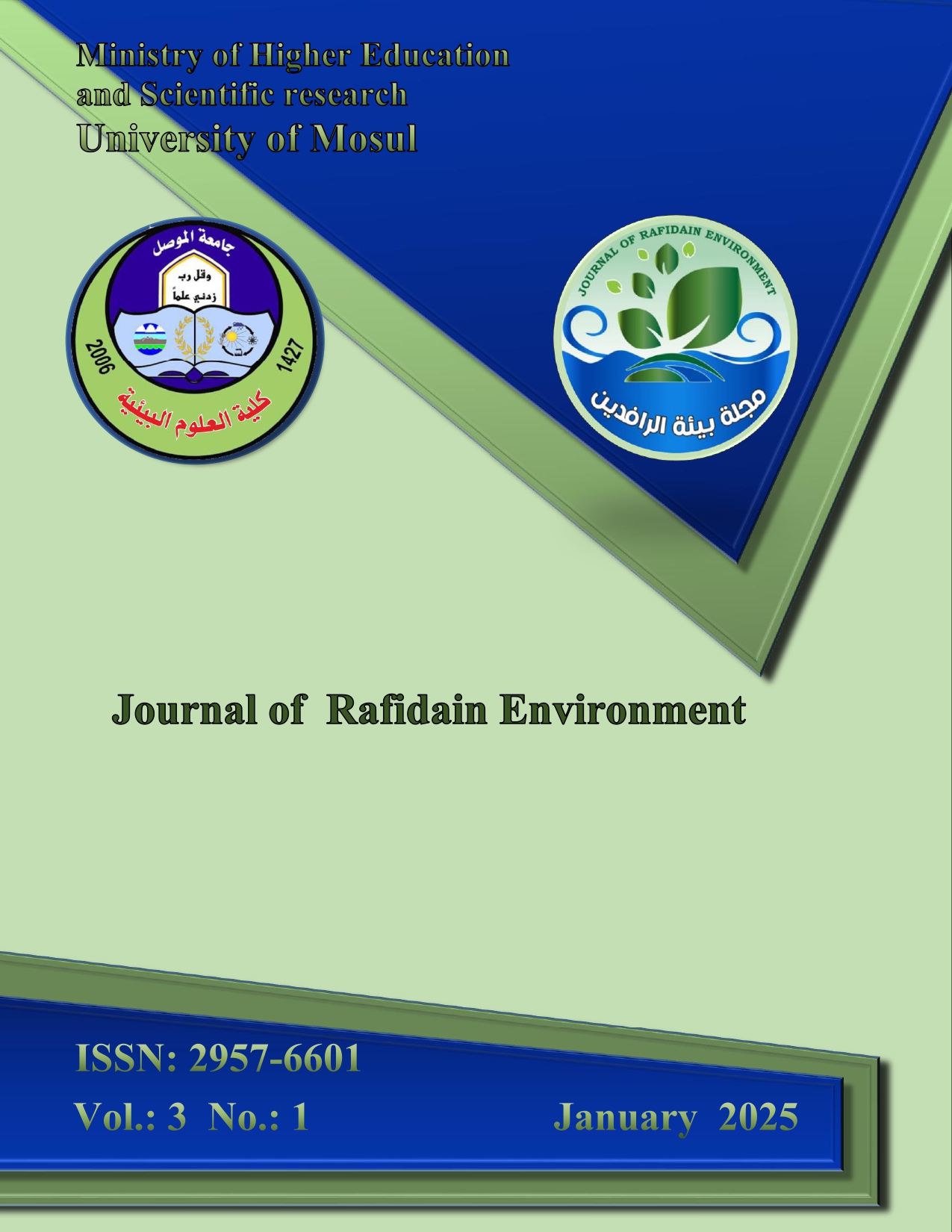دراسة فعالية العكبر ضد Salmonella abony و Candida albicans و تحديد مركباته الفعالة

الملخص
تم جمع عينة العكبر من مدينة دهوك ابتداء من شهر تشرين الأول وحتى نهاية شهر كانون الأول (2023). تم اختبار فعالية العكبر ضد الخميرة Candida albicans ATCC 10231، والبكتيريا Salmonella abony ATCC 6017. أظهر العكبر فعالية تثبيطيه ضد العزلات قيد الدراسة، إذ بلغت نسبة تثبيط نمو C. albicans 19.40% عند تركيز 600 ملغم/مل، في حين بلغت نسبة التثبيط نمو Salmonella abony 18.15% عند نفس التركيز. تم الكشف عن المركبات الكيميائية بواسطة كروماتوغرافيا طبقة التحليل (TLC) التي اظهرت احتواءه على كل منMorin, Caffeic acid, Apigenin, Flavone, Ferulic acid) (، كما تم الكشف عن مركبات كيميائية اخرى عند تحليل عينة العكبر باستخدام تقنية GC-MS حيث لوحظ بان اكثر المركبات وفرة: 2-Propen-1-one, 1-(2,6-dihydroxy-4,1,3-methoxyphenyl)-3-phenyl-, (E)- بنسبة (27%)، ومركب Oleic Acid بنسبة (8.96%)، ومركب Phenylethyl Alcohol وبنسبة (6.95%).
المراجع
- Allawi, M. Y. and Al-Taie, B. S. (2020). Comparison between inhibitory effect of propolis and green apple peel against C. albicans with diagnosis some of the active compounds. Biochemical & Cellular Archives, 20(1).
- Balouiri, M.; Sadiki, M. and Ibnsouda, S. K. (2016). Methods for in vitro evaluating antimicrobial activity: A review. Journal of pharmaceutical analysis, 6(2): 71-79.
- Bankova, V.; Popova, M. and Trusheva, B. (2018). The phytochemistry of the honeybee. Phytochemistry, pp: 1-11.
- Cauich-Kumul, R. and Campos, M. R. S. (2019). Bee propolis: Properties, chemical composition, applications, and potential health effects. In Bioactive compounds, Woodhead Publishing, pp: 227-243.
- Dezmirean, D. S.; Paşca, C.; Moise, A. R. and Bobiş, O. (2020). Plant sources responsible for the chemical composition and main bioactive properties of poplar-type propolis. Plants, 10(1): 1-20.
- Daniels, C. W., Rautenbach, F., Marnewick, J. L., Valentine, A. J., Babajide, O. J., & Mabusela, W. T. (2015). Environmental stress effect on the phytochemistry and antioxidant activity of a South African bulbous geophyte, Gethyllis multifolia L. Bolus. South African Journal of Botany, 96, 29–36. doi: 10.1016/j.sajb.2014.10.004
- Tomaszewski, M. J., & Hartman, T. G. (2016). IDENTIFICATION OF THE KEY AROMA ACTIVE COMPOUNDS OF PROPOLIS COLLECTED FROM CENTRAL NEW JERSEY OVER THREE CONSECUTIVE YEARS.
- Gebara, E. C. E.; Pustiglioni, A. N.; de Lima, L. A. P. A. and Mayer, M. P. A. (2003). Propolis extract as an adjuvant to periodontal treatment. Oral health & preventive dentistry, 1(1).
- Goulson, D.; Nicholls, E.; Botías, C. and Rotheray, E. L. (2015). Bee declines driven by combined stress from parasites, pesticides, and lack of flowers. Science, 347(6229): 1255957.
- Ghavam, M., Afzali, A., & Manca, M. L. (2021). Chemotype of damask rose with oleic acid (9 octadecenoic acid) and its antimicrobial effectiveness. Scientific Reports, 11(1). doi: 10.1038/s41598-021-87604-1
- Harfouch, R. M.; Mohammad, R. and Suliman, H. (2016). Antibacterial activity of Syrian propolis extract against several strains of bacteria in vitro. World J. Pharm. Pharmaceuti, 6: 42-46.
- Illahi, M. F. (2020). In Silico Study of Propolis as a Potential Healing Agent for Gastric Ulcer. Degree M.Sc., College Faculty of Health and Life Sciences, Capital University, Libya.
- Juric, T.; Micic, N.; Potkonjak, A.; Milanov, D.; Dodic, J.; Trivunovic, Z. and Popovic, B. M. (2021). The evaluation of phenolic content, in vitro antioxidant and antibacterial activity of Mentha piperita extracts obtained by natural deep eutectic solvents. Food Chemistry, 362: 130226.
- Merica, M.; Jasprica, I.; Smolcic, A. and Mornar, A. (2004). Optimization of chromatographic conditions in thin layer chromatography of flavonoids and phenolic acids. Croatica chemica acta, 77(1-2): 361-366.
- Pusceddu, M.; Annoscia, D.; Floris, I.; Frizzera, D.; Zanni, V.; Angioni, A. and Nazzi, F. (2021). Honeybees use propolis as a natural pesticide against their major ectoparasite. Proceedings of the Royal Society B, 288(1965): 20212101.
- Rojczyk, E.; Klama-Baryła, A.; Labus, W.; Wilemska-Kucharzewska, K. and Kucharzewski, M. (2020). Historical and modern research on propolis and its application in wound healing and other fields of medicine and contributions by Polish studies. Journal of Ethnopharmacology, 262: 113159.
- Salatino, A. (2022). Perspectives for uses of propolis in therapy against infectious diseases. Molecules, 27(14): 4594.
- Salatino, A. and Salatino, M. L. F. (2021). Scientific note: often quoted, but not factual data about propolis composition. Apidologie, 52(2): 312–314.
- Shanahan, M. and Spivak, M. (2021). Resin use by stingless bees: A review. Insects, 12(8): 719.
- Suran, J.; Cepanec, I.; Masek, T.; Radic, B.; Radic, S.; Tlak Gajger, I. and Vlainic, J. (2021). Propolis extract and its bioactive compounds-From traditional to modern extraction technologies. Molecules, 26(10): 2930.
- Sirilun, S., Chaiyasut, C., Sivamaruthi, B. S., Peerajan, S., Kumar, N., & Kesika, P. (2017). Phenethyl alcohol is an effective non-traditional preservative agent for cosmetic preparations. Asian Journal of Pharmaceutical and Clinical Research, 10(8), 129–133. doi: 10.22159/ajpcr.2017.v10i8.18572
- Zulhendri, F.; Chandrasekaran, K.; Kowacz, M.; Ravalia, M.; Kripal, K.; Fearnley, J. and Perera, C. O. (2021). Antiviral, antibacterial, antifungal, and antiparasitic properties of propolis: A review. Foods, 10(6): 1360.
- Zulhendri, F.; Ravalia, M.; Kripal, K.; Chandrasekaran, K.; Fearnley, J. and Perera, C. O. (2021). Propolis in metabolic syndrome and its associated chronic diseases: A narrative review. Antioxidants, 10(3): 348.
تنزيل هذا الملف
الإحصائيات
##submission.copyrightAndLicensing##

هذا العمل مرخص بموجب Creative Commons Attribution-NonCommercial 4.0 International License.